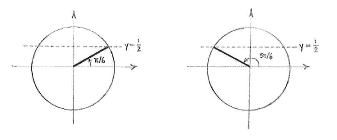Lösung 4.4:2e
Aus Online Mathematik Brückenkurs 1
(Unterschied zwischen Versionen)
K |
|||
| Zeile 1: | Zeile 1: | ||
| - | This is almost the same equation as in exercise d. First, we determine the solutions to the equation | + | This is almost the same equation as in exercise d. First, we determine the solutions to the equation when <math>0\le 5x\le 2\pi</math>, and using the unit circle shows that there are two of these, |
| - | when | + | |
| - | <math>0\le | + | |
| - | + | ||
| - | + | ||
| - | + | ||
| + | {{Displayed math||<math>5x = \frac{\pi}{6}\qquad\text{and}\qquad 5x = \pi - \frac{\pi}{6} = \frac{5\pi}{6}\,\textrm{.}</math>}} | ||
[[Image:4_4_2_e.gif|center]] | [[Image:4_4_2_e.gif|center]] | ||
| - | We obtain the remaining solutions by adding multiples of | + | We obtain the remaining solutions by adding multiples of <math>2\pi</math> to the two solutions above, |
| - | <math>2\pi </math> | + | |
| - | to the two solutions above | + | |
| + | {{Displayed math||<math>5x = \frac{\pi}{6} + 2n\pi\qquad\text{and}\qquad 5x = \frac{5\pi}{6} + 2n\pi\,,</math>}} | ||
| - | + | where ''n'' is an arbitrary integer, or if we divide by 5, | |
| - | + | ||
| - | + | ||
| - | + | ||
| - | + | ||
| - | an arbitrary integer | + | |
| - | + | {{Displayed math||<math>x = \frac{\pi}{30} + \frac{2}{5}n\pi\qquad\text{and}\qquad x = \frac{\pi}{6} + \frac{2}{5}n\pi\,,</math>}} | |
| - | <math>\text{5}</math> | + | |
| - | + | where ''n'' is an arbitrary integer. | |
| - | + | ||
| - | + | ||
| - | + | ||
| - | + | ||
| - | + | ||
| - | an arbitrary integer | + | |
Version vom 14:37, 10. Okt. 2008
This is almost the same equation as in exercise d. First, we determine the solutions to the equation when \displaystyle 0\le 5x\le 2\pi, and using the unit circle shows that there are two of these,
We obtain the remaining solutions by adding multiples of \displaystyle 2\pi to the two solutions above,
where n is an arbitrary integer, or if we divide by 5,
where n is an arbitrary integer.

